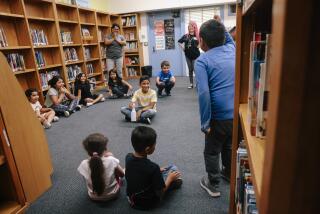Students Eagerly Tutoring Children of the Homeless : Education: Civics classes and school clubs provide volunteers for the Orange Coast Interfaith Shelter project. Pupils 3 to 16 years old have had dramatic improvements.
- Share via
COSTA MESA — High school and college students--so often portrayed as children of the Me Decade--have become eager participants in a new program to tutor homeless children, the program’s creators say.
Guy Foresman, a student minister at the United Church of Christ in Corona del Mar, said he was overwhelmed by the students’ response to his plan for using volunteers to teach children of the Orange Coast Interfaith Shelter.
He said that after pitching his program to six civics classes in the Newport Mesa School District last October, 80 high school students volunteered to tutor at least one hour a week. Another six were recruited from the Circle K Club, a service organization at UC Irvine.
“We had to put up a waiting list,” Foresman said.
During the first months of the program, 13 students were trained to evaluate the children’s strengths and weaknesses and develop weekly lesson plans in math, reading and writing. The sessions are aimed at improving the homeless children’s skills as well as rewarding them for what they already do well, he said.
“If nothing else, it gives the kids at least one day a week to go to school and get an A on their homework,” said Larry Haynes, a family adviser at the shelter who helped develop the program.
School is harsh for homeless children who haven’t developed the social skills of their counterparts and can’t compete materially or academically, he said. “It’s just one inferior experience after another,” he said.
Now there are nine tutors, many of them returning volunteers. Each tutors a child age 3 to 16 who is living in the Costa Mesa shelter, which provides temporary housing for 12 families at a time. Most of the homeless children attend the nearby Pomona School and see their tutors on weekends or after school.
After several weeks, shelter workers saw dramatic improvements in the children’s self-esteem, Haynes said. “Just one hour a week of someone saying you are somebody is like water to a dry sponge.”
On a recent afternoon, UC Irvine sophomore Jessica Katz sat on a pillow on the floor of a small service room, reading an alphabet book to Demarrea Barnes, 3, whose mother had been living in motels since her eviction from her Buena Park lodgings. “A is for apple,” she read. “I want to eat it!” the boy replied.
“I never thought I’d be so interested in helping the homeless,” said Katz, a social ecology major who has volunteered for two quarters in a row.
Reared in the affluent city of Saratoga in Northern California’s Santa Clara County, Katz said that her only image of homeless people had been street people she had seen in Berkeley. “I felt, who are these people? Are they going to take my money? These people aren’t like that. These are normal, average people fallen on hard times, and they need our help.”
She said she still hopes to become rich through a career in international business. “If I am, I want to give it back to other people,” she said.
Foresman plans to expand the program this spring to other shelters. He also hopes to inspire others to develop similar programs. “The intent is to put into place an educational system in tandem with the public school system, so that we can follow this situation around,” he said.
Shelter rules require the families to move on after three months. Some tutors plan to follow their students. Others offered to volunteer at the shelter. “In self-indulgent Orange County, that’s no small feat,” Haynes said.
In Foresman’s view, the pendulum has begun to swing away from greed and toward ideals of charity and justice. “If you attempt to try and address these concerns through concerted action, people are willing to give their assistance,” he said.
More to Read
Sign up for Essential California
The most important California stories and recommendations in your inbox every morning.
You may occasionally receive promotional content from the Los Angeles Times.










